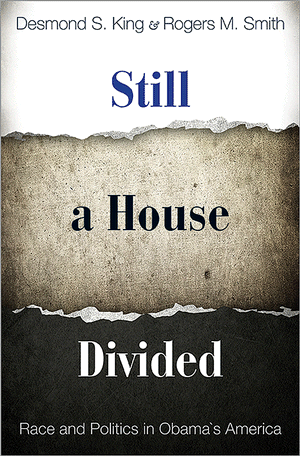Barack X
The New Yorker
2012-10-08
Jelani Cobb, Associate Professor of History and Director of the Institute of African American Studies
University of Connecticut
1. It’s mid-March in Harlem and the streets are an improvised urban bazaar. Young men hawk umbrellas, vintage vinyl, and knit caps. The aromas of curry and fried plantains waft out from the Caribbean spot, and just ahead of me is a teen-ager so slight that I scarcely notice him at first. There’s a perfectly calibrated swagger in his stride. He’s swaddled in an oversized black leather jacket, his jeans cinched five inches below the waist, his footwear immaculate. I’ve nearly passed him before I notice something that makes me pause for a second and then snap a picture with my cell phone: stitched onto the back of the jacket, in dimensions broader than his back, is the seal of the President of the United States. He is standing on Malcolm X Boulevard, and a generation ago that jacket would’ve been emblazoned with a defiant X in homage to a man who defined radical black dissent. There are a dozen questions I could ask him—whether there are metal detectors in his school or when was the last time he was frisked by the N.Y.P.D., whether he sees his future as an amorphous blob of curtailed possibilities or if he has real plans. But I don’t have to ask how the most revered symbol of the American establishment came to adorn his jacket.
In the halcyon days after Barack Obama’s inauguration, newspapers ran stories marvelling at an Obama effect that seemed to lift black students beyond the achievement gap. Some openly hoped that his election would inspire increased numbers of black law-school applicants, the way that “C.S.I.” spawned a generation of forensic-science majors. In a poll taken just after the inauguration, some seventy per cent of respondents said that they expected his tenure to bring an improvement in race relations. Obama himself played to this dynamic early on, saying that in a crowded field of talented Democratic contenders the rationale for his campaign was that his election would tell every child in this country that anything was possible. And for a brief moment, it seemed that might actually be true.
Nearly four years later, the fickle-hearted arbiters of cool have migrated onward, finding new cultural pastures to stake out. There are no A-list rappers crafting themes in Obama’s honor, no catchy call-and-response phrases on par with “fired up and ready to go.” Yet here on Lenox Avenue is an Obama testimony in clashing motifs that underscores the complexity of the President’s current undertaking. A handful of men have been elected President and then become a symbol for an era, but very few beyond the current occupant of 1600 Pennsylvania Avenue have made the opposite transition. And it is for this reason that 2012 seems like so much anticlimax: a symbol ran for President four years ago; today a man is seeking to hold onto that position…
…2. The more onerous aspects of Jim Crow conspired to obscure a reality key to understanding Barack Obama’s complicated relationship to black America: simply put, the colored section was far more democratic than the ostensibly free segments of America because virtually any tincture of black ancestry was sufficient to gain admission. The boundaries of whiteness required vigilant policing and scrutiny, but black people were far more catholic in our self-perception.
In response, America conjured a usable mythology, one in which the product of interracial unions were uniformly doomed to suffer disproportionate woe. Fiction, folklore, and films like “Imitation of Life” cinched the concept of the tragic mulatto in American popular imagination. But the concept didn’t square with our own lived experience. There was nothing tragic about the trajectories of Frederick Douglass, Booker T. Washington, Mordecai Johnson, or any other biracial black person—aside from the burden of racial inequality they shouldered along with anyone else of African descent. The activist Walter White used his nearly white skin as a kind of camouflage that allowed him to investigate lynchings for the N.A.A.C.P. in the nineteen-twenties. Obama understood this history well enough to stand nearly outside of it. In 2008, Barack Obama authored a new archetype—a biracial man who was not so much tragic as ironic. Unlike the maligned mulattoes of old, Obama wasn’t passing for white—he was passing for mixed. For those with an eye to this history it was a masterful performance, a riff as adroit as anything conjured by Dizzy Gillespie or Sonny Rollins.
Early on, observers noted Obama’s Ebonic lapses when speaking to black audiences and saw in them a sly attempt to pander to African-American voters. But they had it precisely backward: to black audiences, his ability to speak in pulpit inflections one moment and concave Midwestern tones the next made him seem more black, not less. We saw him as no different than any African-American lawyer who speaks black English at home and another, entirely more formal language, in his professional environment.
Not surprisingly this has translated into confusion over who the President of the United States is. A 2010 Pew poll showed that fifty-three per cent of whites see the President as biracial while only a quarter see him as black. At the same time, fifty-five per cent of African-Americans see Obama as black while a third see him as mixed race. What the poll failed to ask, however, was whether African-Americans see those two categories as mutually exclusive. Slavery, coercion, and the randomness of social exchange conspired to ensure that virtually all of black America is biracial in some regard. Walter White had blonde hair, fair skin, and blue eyes—yet was black enough to serve as the N.A.A.C.P.’s chief executive for twenty-four years. What was known but left unsaid is that Obama was at least as black as any of the other forty million of us and biracial in the same sense that Douglass, Washington, and White were…
Read the entire article here.


